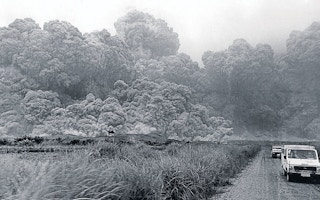Data gathered in the high atmosphere would be invaluable in determining whether so-called “geoengineering” solutions had any merit at all.
It would have to be an event on the scale of Mount Pinatubo in 1991.
That eruption cooled global temperatures for a couple of years.
It did so by pumping 20 million tonnes of sulphur dioxide high into the sky above the Philippines.
The resulting droplets of sulphuric acid that formed on contact with moisture reflected incoming sunlight back out into space, preventing that radiation from warming the surface.
Some have suggested humanity could mimic this same effect by deliberately seeding the stratosphere with sulphur.
Missing information
But Prof Alan Robock from Rutgers University said we had no real knowledge currently of how such a strategy would play out.
“
I don’t like the Plan B framing; I tend to think of it as Plan Z.
Professor Steve Gardiner, University of Washington
That is why he wants to see a co-ordinated investigation of the next big volcanic eruption to gather additional data.
“We’d like to be able to see how this sulphur dioxide cloud evolves from gas into particles and how the particles grow. If the particles are too big then they’ll fall out much more rapidly and you’d have to replenish them much more rapidly, if you’re interested in doing geoengineering. And so we’d like to understand the processes in the formation of these droplets,” he told BBC News.
Prof Robock was speaking in San Jose at the annual meeting of the American Association for the Advancement of Science.
He and other experts were discussing the US National Research Council report published this week on geoengineering.
The committee members found there was presently insufficient insight into the likely consequences of climate intervention techniques to justify their use.
‘Plan Z’
On many themes, the NRC report echoed UK Royal Society findings released last year.
Geoengineering is often described as a “Plan B” that could be implemented if the world could not agree a “Plan A” to reduce carbon dioxide and other greenhouse gas emissions blamed for warming the climate - a kind of last-resort or technical fix.
Many scientists researching the area though are deeply sceptical that geoengineering has any role to play, because of the uncertainties involved. For example, as well as cooling the climate, Mt Pinatubo disrupted the Asian Monsoons and by limiting direct sunlight reduced the capability of solar power generation.
“I don’t like the Plan B framing; I tend to think of it as Plan Z,” Prof Steve Gardiner, of the University of Washington, told the meeting. And Prof Robock himself said: “People who work on this don’t want to work on this.”
Nonetheless, the committee believes the research should go on. “And so that research programme would involve modelling, observations, and possibly some small experiments that can be conducted at low risk,” said Prof Lynn Russell, from the Scripps Institution of Oceanography.
‘No alternative?’
However, the necessary instrumentation to follow through on the research programme also needed to be put in place, added Prof Robock.
A proper study of droplet behaviour in another Pinatubo-like event would need balloons, aircraft, lidars, and satellites that could look down through and across the eruption plume. This was not currently available, Prof Robock said.
“We need more information to know what the relative benefits and the relative risks would be, and so we need a lot more research.
“I hope if in the future global warming continues and the world gets towards more dangerous impacts, that policymakers will have more information to make this decision.
“But if our research very quickly shows that it is not going to work, that it’s going to be more risky to do it than not do it, that’ll have a much stronger incentive to stop putting carbon dioxide into the atmosphere because there will be no alternative.”










